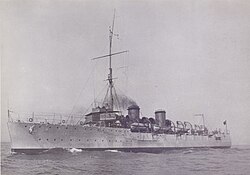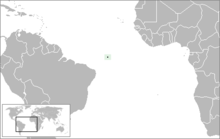Bahia (1909)
|
||||||||||||||||||
|
||||||||||||||||||
|
||||||||||||||||||
|
||||||||||||||||||
The Bahia was a Brazilian protected cruiser ( Portuguese : cruzador ), named after the Brazilian state of Bahia . He took an active part in both the First and Second World Wars . The Bahia sank on July 4, 1945 near the Sankt-Peter-und-Sankt-Pauls-Felsen by an accident during a target practice within three minutes, whereby the vast majority of the crew was killed. The Brazilian authorities initially blamed the German submarine U 530 , later U 977 , for the sinking , both of which were independently on their way to internment in Argentina after the unconditional surrender of the Wehrmacht on May 8, 1945 . Although the sinking was officially unequivocally clarified by an investigation by Brazilian and US naval authorities, the conspiracy theory continues to this day that U 977 sank the Bahia .
period of service
Naval mutiny 1910
During the naval mutiny in 1910 , the mutineers murdered an officer from the cruiser.
First World War
After Brazil entered the First World War on October 26, 1917, the Bahia was used with other Brazilian units to support the Royal Navy in the South Atlantic and on January 30, 1918, the flagship of the "Divisão Naval em Operações de Guerra" (DNOG = Naval Division in War Operations) ) under the command of Rear Admiral Pedro Max Fernando Frontin.
From August 1918, the division was used in West Africa in front of the British colony of Sierra Leone , the French port of Dakar and the Free State of Liberia . Their job was mine clearance and convoy protection from German submarines . On September 6, the Spanish flu broke out on board the Bahia in the port of Dakar and spread to the other units. At times, up to 95% of some of the ship's crews were sick. Of the Brazilian teams, 103 relatives died, 250 sick people were transported to Brazil as incapacitated, where a large number also died as a result of the consequences of the illness.
On November 3, 1918, the cruiser was ordered with other units to Gibraltar to be used in the Mediterranean , which was made obsolete by the Armistice of Compiègne on November 11, 1918.
Interwar period
In 1925/26 the Bahia was thoroughly modernized and switched to oil firing. The armament was expanded to include two torpedo tubes, two 3-inch guns and a few machine guns . In 1930 the cruiser took part in a Brazilian fleet visit to the United States . In 1930, 1932 and 1935 the Bahia was used against insurgents by the government, for example in the state of Santa Catarina and the ports of Santos and Natal .
Second World War
After Brazil entered the Second World War on August 21, 1942, the cruiser was used intensively to escort convoys. In 1942 and 1944 it was modernized again and equipped with radar , sonar and devices for dropping depth charges. In November 1944, the Bahia accompanied the troop transport General MC Meigs , on which units of the Brazilian Expeditionary Corps were embarked in Europe , to Italy .
Doom and Conspiracy Theory
After the unconditional surrender of the Wehrmacht on May 8, 1945, Brazilian naval units also remained on the high seas in order to serve as rescue ships for US aircraft, on which troops were shipped from the European to the Pacific theater of war. on June 6, 1945, Brazil declared war on the Japanese Empire .
In an air defense exercise on July 4, 1945 near the Saint Peter and Saint Paul Archipelago, about 1000 km off the northeastern coast of Brazil, met one or more 20-mm grenades of Oerlikon -Flugabwehrgeschützes the target practice apparatus behind the ship, however, also the depth of charge at the stern of the cruiser, which was only possible due to the lack of guardrails to prevent the ship from being shot at.
The machinery immediately failed when the depth charges exploded. The ship sank within three minutes without an emergency call being made. The sinking of the Bahia was therefore only registered four days later, when the releasing sister ship Rio Grande do Sul appeared at the place of the sinking and did not find the cruiser. On July 8, 22 survivors were taken in by the British steamer Balfe (1920-1959). The information about the crew losses varies depending on the source, officially 36 seamen were registered as rescued and 336 as losses, including four radio operators of the United States Navy . A lifeboat with survivors reached the Brazilian coast on its own. Survivors who had rescued themselves on life rafts died from high daytime temperatures and lack of water or from sharks .
According to reports from survivors, the ship appeared to have run into a sea mine . When the German submarine U 530 ran into Mar del Plata , Argentina, on July 10, 1945, six days after the accident and two days after the Balfe had rescued some survivors , the head of the Brazilian naval intelligence service , Vice Admiral Jorge Dodsworth Martins , suspected that U 530 sank the Bahia . The Argentine Navy stated, however, that U 530 could not have sunk the Bahia because the distance between the place of the sinking and Mar del Plata was too great to be overcome in six days.
When U 977 arrived in Mar del Plata on August 17, 1945 , the Brazilian allegations were renewed. However, a joint investigation by the Brazilian and US naval authorities came to the conclusion that the only possible cause of the loss was the accident that I was responsible for; The main witness was the only surviving officer of the Bahia , who in his interrogation accused the ship's command of having neglected the safety measures.
These investigations were questioned by the Argentine journalist of Hungarian origin Ladislao Szabó in his 1947 work " Hitler está vivo " ("Hitler is alive") and have been questioned until the present day, most recently by the Argentine authors Salinas and de Nápoli. Both submarines would have belonged to a ghost convoy ( Spanish convoi fantasma ), which possibly comprised a total of five submarines and with which leading National Socialist functionaries would have been secretly brought to Argentina, u. a. Adolf Hitler , his wife Eva Braun and Martin Bormann . At the time, Szabó even made the claim that the refugees might have been transported to Neuschwabenland , which is why US Admiral Richard Evelyn Byrd carried out his Antarctic expedition ( Operation Highjump ) in 1947 to track down the refugees. In 2006, Salinas / de Nápoli claimed that the Brazilian investigation report was falsified in order to cover up the sinking of the Bahia by U 977 . The commander of U 977 , Heinz Schaeffer, had already described Szabó's claims in his memoir, first published in 1950, as the fantasies of a layman who had no knowledge of seafaring .
literature
- Captain lieutenant a. D. B. Weyer : Taschenbuch der Kriegsflotten , XV. Born 1914, Munich 1914, pp. 22f., 168f., 367
- Corvette Captain d. R. Alexander Bredt (ed.): Weyers Taschenbuch der Kriegsflotten , XXXVI. Born 1943/44, Munich / Berlin 1944, pp. 20f., 312
- Robert L. Scheina: Latin America's Wars , Vol. II., P. 427, note 52.
- Robert L. Scheina: Latin America. A Naval History 1810-1987 , Annapolis, MD (Naval Institute Press) 1987, pp. 96f., 160. ISBN 0-87021-295-8
- Ladislao Szabó: Hitler está vivo , Buenos Aires (Editorial El Tabanao) 1947.
- Juan Salinas / Carlos de Nápoli: Ultramar sur. La fuga en submarinos de más de 50 jerarcas Nazis , Barcelona (Belacqva) 2006. ISBN 84-96326-66-7
- Heinz Schaeffer: U-977. 66 days under water , Wiesbaden (Limes Verlag) 1950.




